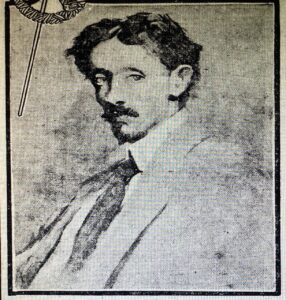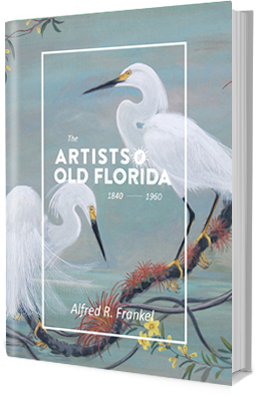 Phineas E. Paist, Mermaids, oil on board, 48 by 60 inches. Signed lower right Phineas E. Paist 1932.
Phineas E. Paist, Mermaids, oil on board, 48 by 60 inches. Signed lower right Phineas E. Paist 1932.
In January of 1916, Paul Chalfin was in trouble, James Deering was not happy with the progress of work on his dream home, Vizcaya. Chalfin was working from New York, but Deering wanted someone supervising on site in Miami. Chalfin, after some sleepless nights, brought down to Miami from Philadelphia the architect Phineas E. Paist.
Nietzsche said, “art is the proper task of life, art is life’s metaphysical exercise…art is worth more than truth.” It was Phineas Paist who brought the idea of Art, Art with capital letters, Art as being important to the daily lives of Miamians. It was Paist who was responsible for a long list of important Miami historical architectural sites including Vizcaya, the Miami Federal Courthouse, the Douglas entrance to Coral Gables, the Colonnade, the Venetian Pool, Coral Gables City Hall and the Florida Pavilion at the Chicago Century of Progress in 1933.
When he died in 1937, the Miami Daily News editorialized. “It is not given to many men to leave physical monuments behind them when they die. Because he was an architect and more than that, an artist, Phineas E. Paist has passed on as an exception to this rule. For Mr. Paist lives on in Miami not only in the hearts of the friends he made or the memory of good causes he served, but also in the beauty that meets each resident and each traveler who visits the landscapes he laid out and the buildings he conceived. The beauty of Coral Gables is of Mr. Paist. The magnificence of the James Deering estate is of Mr. Paist. For these two monuments alone, he will live in eyes that are privileged to absorb the charms they shed. It is a rich heritage Greater Miami receives from Phineas E. Paist.”
Phineas E. Paist, Vizcaya, oil on board, 48 by 60 inches. Signed lower right, Phineas E. Paist 1930.
Born in 1873, Phineas Paist grew up on a 135-acre farm in New London, Pennsylvania, the son of a prominent Chester County farmer who was also superintendent of the Farmers Market in Philadelphia. He was ten years old when his father died in 1883.
In 1893 Paist was a twenty-year-old draftsman working for Philadelphia architect S. Gifford Slocum while attending the Drexel Institute of Art Science and Industry. From 1893 to 1900 Paist listed as a draftsman and architect in the Philadelphia city directories. In 1900 Paist began an association with architect George W. Hewitt. He continued his studies in architecture at the Pennsylvania Academy of the Fine Arts and by June of 1903 had won a Cresson scholarship for a year in the Academy’s architecture department.
Paist met Anna Wendle a young woman attending the University of Pennsylvania and a passionate believer in the ideas of Dr. Maria Montessori on the education of children. They married, and on graduation in 1904, Paist won the $1,000, the Cresson Traveling Scholarship in architecture. He and Anna were able to travel for post graduate work in France and Italy. Paist to study in Paris and Rome and Anna to begin her studies in Rome with Maria Montessori. The Cresson Scholarship was continued for a second year of study abroad. The Paist’s spent the summer of 1905 in Rome, moving to Paris in November 1905.
Returning home in 1906, Paist again associated with the Hewitt architectural firm, eventually becoming a partner. A member of the Fellowship of The Pennsylvania Academy of the Fine Arts when the eighth annual exhibit of the Fellowship opened in October 1907, an oil portrait of Paist was exhibited and published in the Philadelphia Inquirer.
 Phineas Paist, circa 1907, by Morris Molarsky, published Philadelphia Inquirer, October 27, 1907.
Phineas Paist, circa 1907, by Morris Molarsky, published Philadelphia Inquirer, October 27, 1907.
In 1914 Anna Paist opened one of the first Montessori schools in the nation at 409 South 2nd St. in Philadelphia, and later in 1916, the Montessori Children’s Village near Wycombe, Bucks County, Pennsylvania, a school she operated until her retirement in 1956. The couple had two son’s and divorced in 1921.
Paist was associate architect on the famous Willard Hotel in Washington, D.C. when Paul Chalfin brought him down to Miami from Philadelphia as his personal representative and associate architect, supervising work on the Deering estate.
In 1924, in association with George Merrick, Denman Fink, and architect Walter DeGarmo, Paist was working on the Douglas Entrance to Merrick’s new city, Coral Gables. Paist became supervising architect of the Coral Gables Corporation in 1925, responsible for, with his new associate Harold Steward, the architectural plans for thirty-four private homes, a hotel, three office buildings, including the Colonnade, the Art Center Building, Coral Gables City Hall, and in Miami, the Federal Court House, and Post Office. Paist’s Mediterranean revival style defined the architecture of Coral Gables.
He died in Miami on May 2, 1937; his death noted by the editors of the Miami Herald, May 13, 1937, “Passing of an Artist. A number of days have gone by since the sudden death in Miami, of Phineas Paist. And yet it is a curious thing that people are talking about him and his work more even than they did when the first grief of his death was upon them. Nothing more clearly demonstrates the fineness of the man and of the things he stood for than that increasing rather than diminishing, sense of loss.
In all his years in Miami Phineas Paist was a quiet, even a retiring figure. Living to himself and working without saying very much, day after day, over his drawing board, people who knew him only slightly still remember the curious keenness of his blue eye and the serenity of his disposition. Many others knew him a little better, as a man who in a curiously unobtrusive way was always doing something kind for someone, stopping in, week after week, to visit with a sick draftsman or an old lady who was lonely.
It is not necessary to describe Phineas Paist to the hundreds of people who are still missing him. But to the general public of Miami, those who walk into the post office every day, those who ride by the splendid masses of the Douglas entrance to Coral Gables, it is important that they recognize what this man meant to the city which we are still building.
No city can ever be built finely and beautifully, that has not been affected by such an artist as Phineas Paist. … There was his sense of standard in art, his knowledge of all the great and fine things that have been built in the world, which he brought to the service of this city…. His sense of beauty, of proportion, of fitness, will live among us for all to study and appreciate…. May the standards which he set for this city be always as well fulfilled.”
Born: August 28, 1873, Franklin, Pennsylvania. Died: May 2, 1937, Miami, Florida. Education: Drexel Institute of Art Science, and Industry; Pennsylvania Academy of the Fine Arts, Cresson Traveling Scholarship; Ecole de Beau Arts, Paris. Membership: Florida Society of Arts and Sciences; Art Institute of Miami; Florida Association of Architects; Fellowship of The Pennsylvania Academy of Art; American Institute of Architects. Exhibits: Coral Gables Elementary School, Art Exhibit, April 1928; Miami Woman’s Club, 2nd Annual Artists’ Salon, February 1930; Art Institute Miami, 1st Annual Show, Biltmore Hotel, Coral Gables, 1933, Florida, The Mermaid, Royal Poincianas. Directory: Listed in the Miami City Directory in 1939 as an artist with a studio at 2901 Ponce De Leon Blvd.




